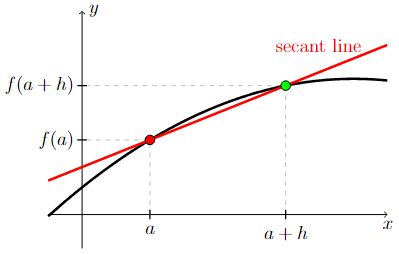The Concept of the Derivative#
Definitions#
Definition
The average rate of change of \(f(x)\) over the interval \([a, a+h]\), which is also the slope of the line secant to the graph of \(f(x)\) through the points \((a,f(a))\) and \((a+h, f(a+h))\), is given by

Long Text Description
There is a horizontal x-axis with points a and a+h marked. There is a vertical y-axis with the points f(a) and f(a+h) marked. The graph of a generic function is drawn. The point (a,f(a)) is marked by a red dot on the graph of the function. The point (a+h, f(a+h)) is marked by a green dot on the graph of the function. A red line is drawn through the points (a,f(a)) and (a+h,f(a+h)) and is labeled as the secant line.
Definition
The instantaneous rate of change of \(f(x)\) at \(x=a\), which is also the slope of the line tangent to the graph of \(f(x)\) at \((a,f(a))\), is given by
if the limit exists.

Long Text Description
There is a horizontal x-axis with point a marked. There is a vertical y-axis with the point f(a) marked. The graph of a generic function is drawn. The point (a,f(a)) is marked by a red dot on the graph of the function. A gray line is drawn through the point (a,f(a)) and is labeled as the tangent line. The tangent line is drawn so that it closely resembles the graph of the function near the point (a,f(a)).
The Limit Definition of the Derivative
The derivative of \(f(x)\) with respect to \(x\), denoted \(f'(x)\), is the function defined as
and the domain of \(f'(x)\) is the set of all \(x\) where the limit exists.
Notation
For a given function, \(y = f(x)\), each of the following symbols refers to the derivative of \(f(x)\) with respect to \(x\).
The Equation of a Tangent Line
The equation of the line tangent to \(f(x)\) at \(x=a\) is given by
The above equation is equivalent to the point-slope equation of a line (i.e., \(y=m(x-a) + b\)) where the slope, \(m\), is equal to \(f'(a)\), and the line goes through the point \((a,b)\), where \(b = f(a)\).
Computing Derivatives Using the Limit Definition#
Simplify the Difference Quotient
When computing the derivative, \(f'(x)\), using its limit definition, it turns out that the limit will most likely be an indeterminate form of type \(0/0\). This means that to evaluate the limit, we’ll have to simplify the difference quotient
until we can cancel out the factor of \(h\) in the denominator. This simplification will usually consist of some combination of expanding (e.g., FOIL) and/or rationalization.
Once the factor of \(h\) in the denominator has been cancelled out, we can evaluate the limit by plugging in \(h=0\).
Example 1#
Equation of a tangent line
Compute the slope of the line tangent to \(f(x)=3x^2+12\) at \(x=5\) using the limit definition of the derivative. Then write down the equation of the line tangent to \(f(x)\) at \(x=5\).
Step 1: Write down the limit definition of a derivative.
Remember: \(f(x+h)\) means that we take \(f(x)\) and replace every occurrence of \(x\) with \((x+h)\). For example, if \(f(x) = x^2\), then \(f(x+h)=(x+h)^2=x^2+2xh+h^2.\)
Step 2: Plug \(f(5+h)\) and \(f(5)\) into definition.
Recall that the slope of the line tagent to \(f(x)\) at \(x=5\) is given by \(f'(5)\). To compute \(f'(5)\), plug \(f(5+h) = 3(5+h)^2 + 12\) and \(f(5) = 3(5)^2 + 12 = 87\) into the limit definition of the derivative.
Step 3: Simplify the Difference Quotient
Simplify until we can factor out an \(h\) in the numerator and cancel it with the factor of \(h\) in the denominator.
The last step of cancelling out the \(h\) assumes \(h\neq 0\). Note that when we evaluate the limit as \(h\) goes to zero in the next step, this will be a valid assumption.
Step 4: Evaluate the limit.
Step 5: Write down the equation of the tangent line.
From Steps 2 and 4, we know \(f(5) = 87\) and \(f'(5) = 30\). Therefore, the equation of the tangent line is given by
Example 2#
Compute the derivative at a point
Compute the derivative of \(f(x)=\dfrac{3}{x+2}\) at \(x=1\) using the limit definition of the derivative.
Step 1: Write down the limit definition of a derivative.
Step 2: Plug \(f(1+h)\) and \(f(1)\) into definition.
To compute \(f'(1)\), plug \(f(1+h) = \frac{3}{1+h+2} = \frac{3}{3+h}\) and \(f(1) = \frac{3}{1+2} = 1\) into the limit definition of the derivative.
Step 3: Simplify the Difference Quotient
Simplify until we can cancel out the factor of \(h\) in the denominator.
Step 4: Evaluate the limit.
Therefore, the derivative of \(f(x)\) at \(x=1\) is equal to \(-1/3\).
Example 3#
Derivative of a square root function
Compute the derivative of \(f(x)=3\sqrt{x}\) using the limit definition of the derivative.
Step 1: Write down the limit definition of a derivative.
Step 2: Plug \(f(x+h)\) and \(f(x)\) into definition.
Plug \(f(x+h) = 3\sqrt{x+h}\) and \(f(x) = 3\sqrt{x}\) into the limit definition of the derivative.
Step 3: Rationalize, FOIL, and simplify.
Notice how making use of the formula \((\sqrt{A} - \sqrt{B})(\sqrt{A} + \sqrt{B}) = A - B\) can help eliminate some of the above computations.
Step 4: Cancel the \(h\) in the numerator with the \(h\) in the denominator.
Step 5: Evaluate the limit.
Therefore, the derivative of \(f(x)\) is equal to \(\frac{3}{2\sqrt{x}}\).
